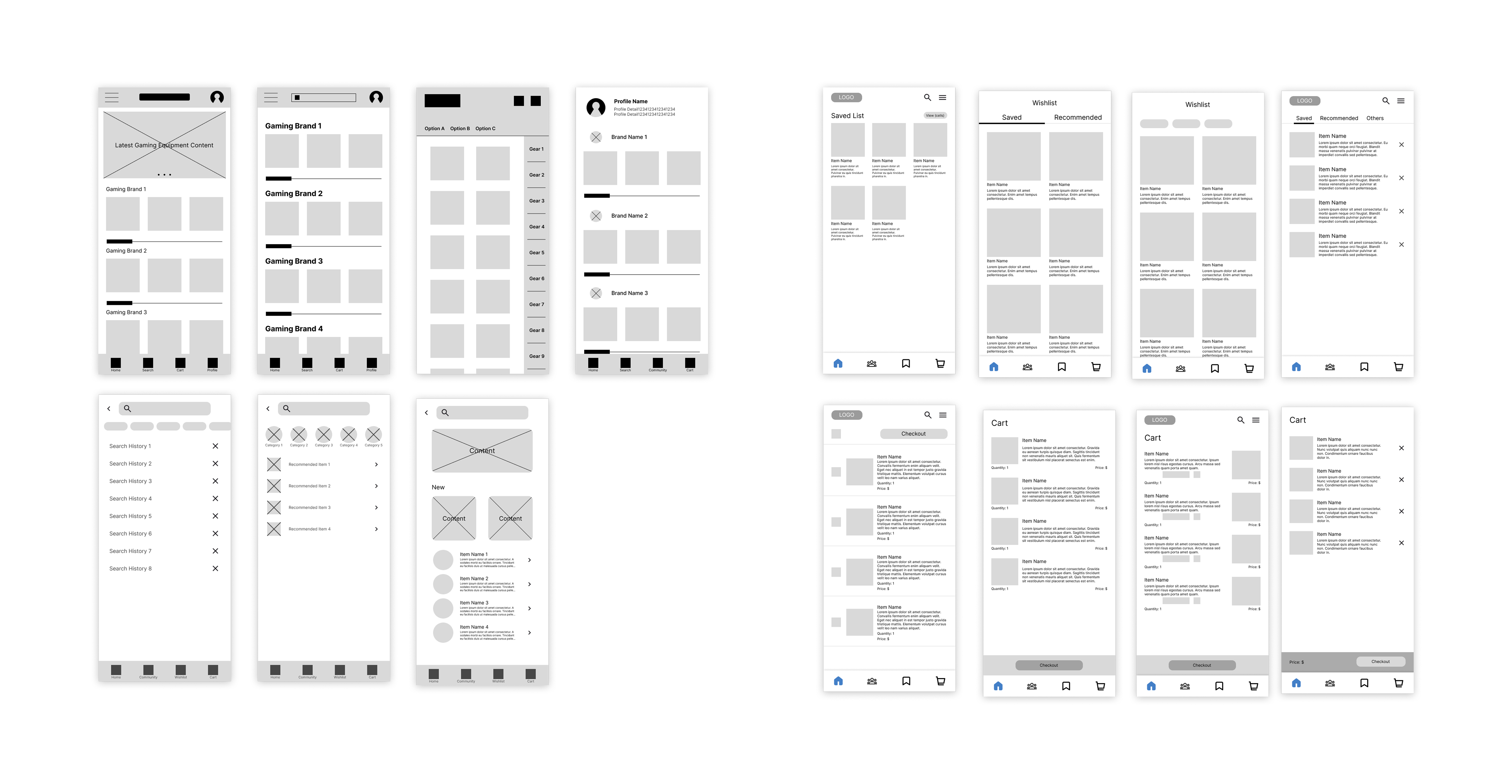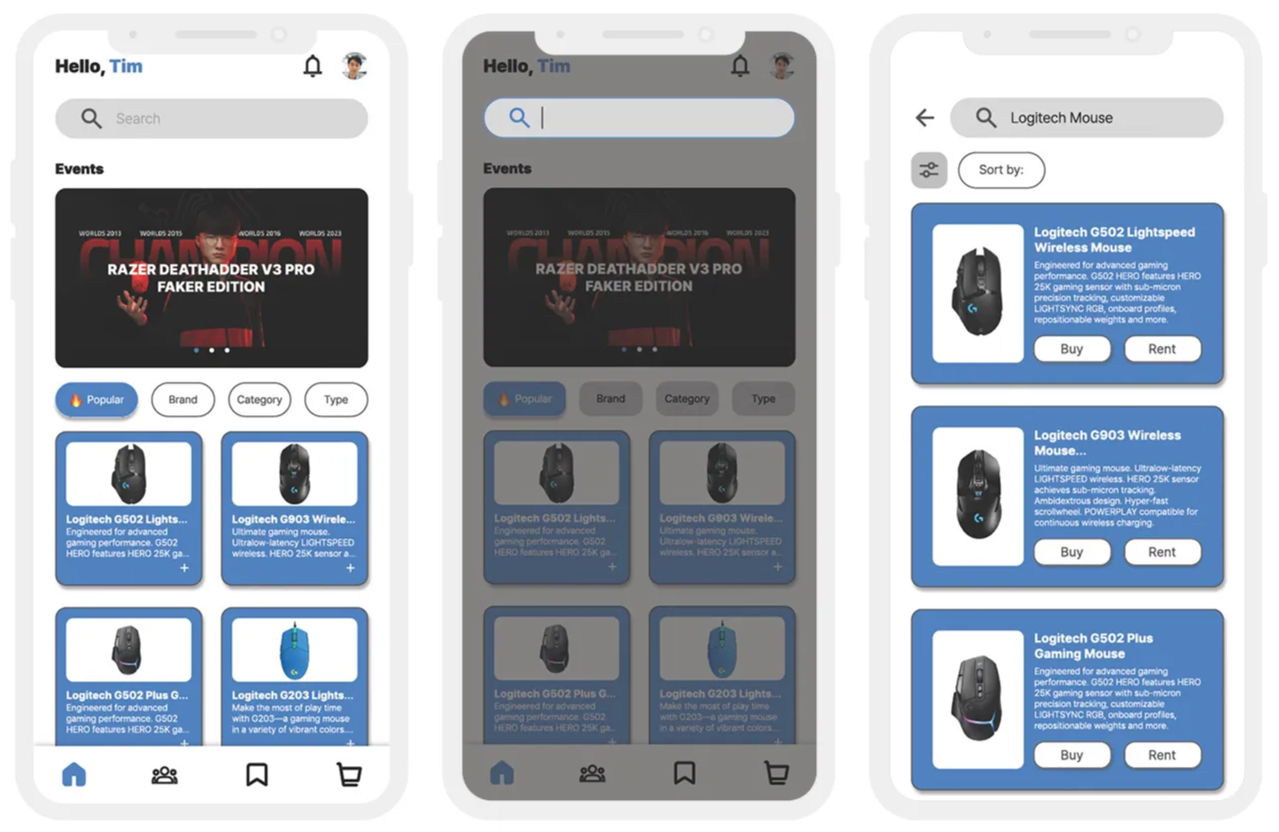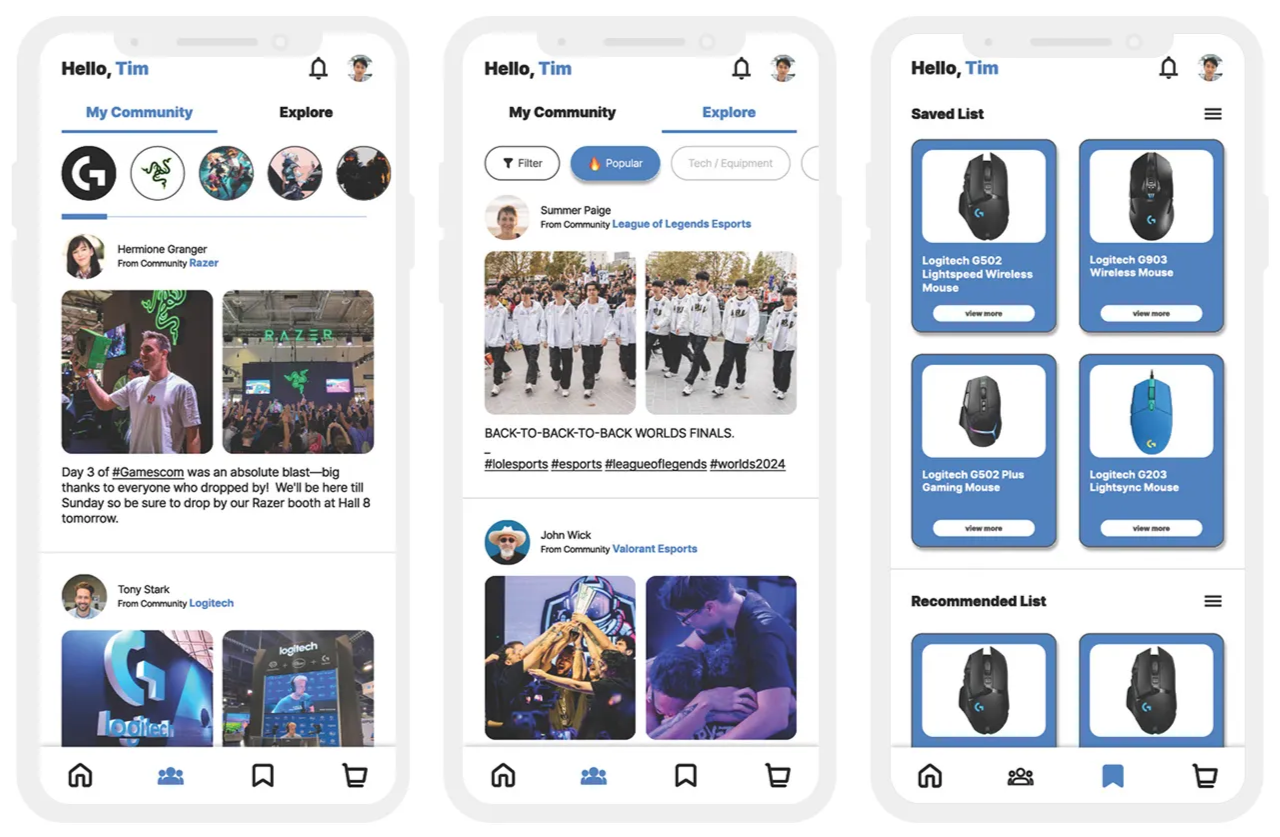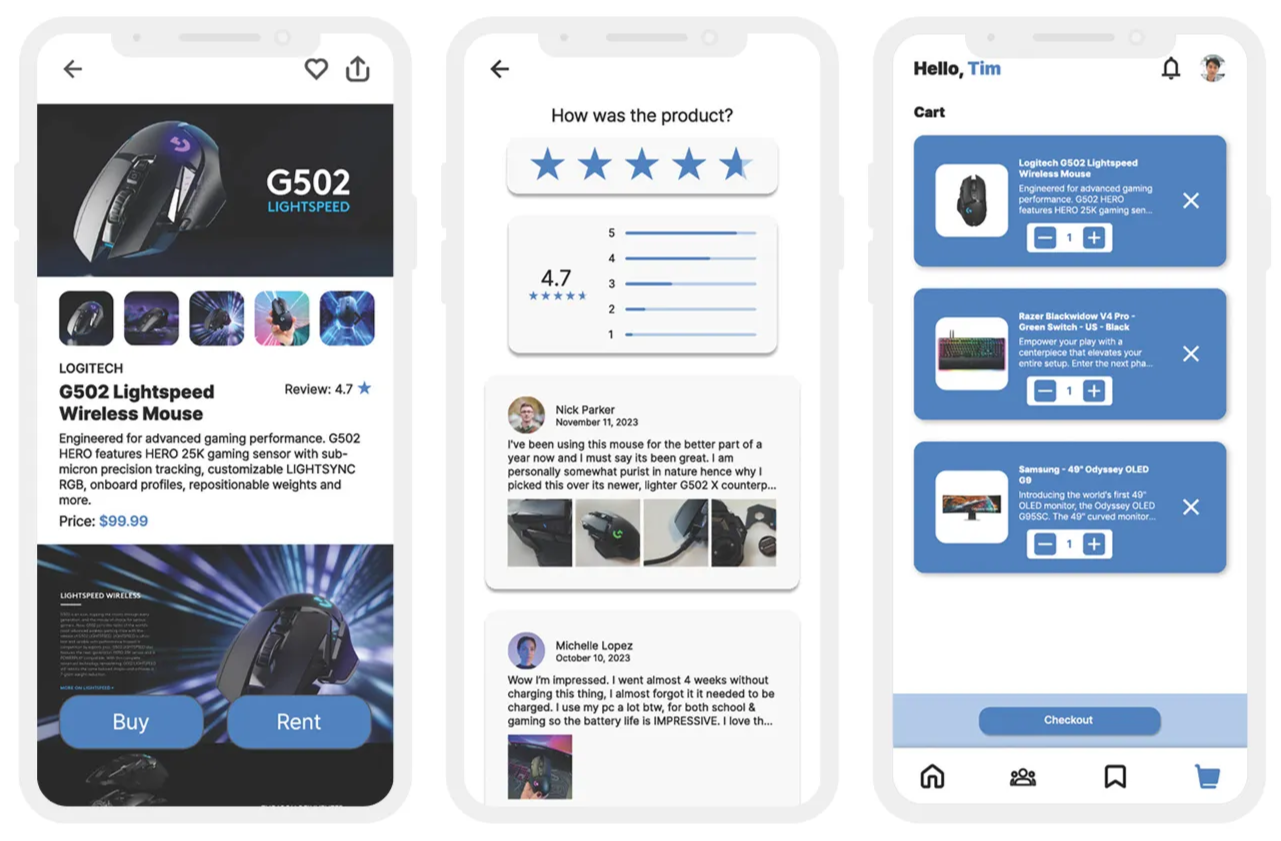Gaming equipment represents a significant investment for players, yet many struggle to access high-quality gear due to budget constraints or uncertainty about whether expensive items are worth the price. Traditional e-commerce platforms treat gaming equipment like any other product, missing the opportunity to build trust and community around shared interests. GameNight was designed to bridge this gap by creating a specialized marketplace that combines flexible rental options with community-driven insights, enabling gamers to make informed decisions while connecting with like-minded players. The platform transforms equipment discovery from a transactional experience into a collaborative journey, where user reviews, community discussions, and rental trials help gamers find the perfect setup without the financial risk.
GameNight
The next-level game equipment app: Rent or buy the latest gaming equipments with the exclusive community features
.png)
Introduction
Research
Target Audience
- Tech-Savvy Young Adults (Ages 16–35)
- Casual and Hardcore Gamers - Individuals who regularly play video games and are looking to buy or sell gaming consoles, accessories, or custom setups.
- Budget-Conscious Buyers - Gamers who want quality equipment without paying full retail price, including students and entry-level players.
Problem Statement
Gamers often struggle to find reliable, affordable, and local sources for buying and selling gaming equipment. Existing marketplaces are either too broad, lack trust within the gaming community, or don't cater specifically to gamers' needs.
User Research
User Interview Key Insights
- Most e-commerce apps for gaming equipment offer limited flexibility and no social component. Gamers lack a central platform to rent gear, connect with other players, and receive authentic feedback before investing in equipment.
- Surveyed with 10 gamers revealed that 70% wanted a rental option to try expensive gear.
- Feedback emphasized the need for a clear rental return process and community-driven reviews. So, I adjusted UI to simplify these workflows.
Solution
A gaming equipment app with multi-channel accessibility for purchasing and renting gear, integrated with a community-first approach to create an engaging and informed user experience.
User Persona
.png)
Mike Marquez
Student
"To me, the real grind isn't just in the books. It's in getting the perfect setup, leveling up my gear, and finding that sweet spot between study sessions and gaming marathons."
- Mike is a 21-year-old student at Vanderbilt University, originally from Atlanta, Georgia, currently living in a dorm with one older brother back home.
- He's a dedicated gamer who takes his setup and specs seriously and wants to connect with a like-minded community.
- He hopes to find honest reviews and fair prices on gaming gear without being bombarded by ads or biased recommendations.
- Mike is frustrated by the overwhelming number of online platforms, which makes it time-consuming to find the right products.
- He distrusts overly positive, ad-driven reviews and struggles to identify reliable listings or sellers.
Competitive Analysis
.png)
Amazon
Pros
- Huge selection of gaming products from verified sellers and brands
- Fast and reliable shipping with Prime membership
Cons
- Reviews can be manipulated or vague, making it hard to trust quality
- Lacks community feel or peer-to-peer interaction tailored to gamers
.png)
Walmart
Pros
- Competitive pricing with regular discounts on gaming gear
- Easy in-store pickup and nationwide availability
Cons
- Limited customization or niche gaming products compared to specialized platforms
- Reviews are often minimal and lack depth for serious gamers
.png)
Facebook MP
Pros
- Local, peer-to-peer buying with room for negotiation
- Wide variety of secondhand gaming gear and bundles
Cons
- Risk of scams or unreliable sellers with no buyer protection
- No focused gaming category or filtering based on specs/performance
Wireframes
Low-Fidelity Design


Exploring Features, Flow, and Data Use
- We mapped out key flows to help users browse gaming gear by brand, search with history recall, and discover curated recommendations. The early sketches emphasized balancing content browsing with transactional features, integrating browsing by gaming brand, trending content, and gear categories directly into the homepage.
- The structure supports a community-oriented marketplace, combining content discovery (e.g., featured posts and reviews) with commerce. We prototyped components like user reviews, gear ratings, and seller credibility signals to build trust and transparency in each product listing.
- Search functionality was refined to leverage user behavior, with saved search histories, recommended results, and category tabs for faster filtering. These features were designed to help gamers like our user persona Mike avoid "option fatigue" by narrowing down results efficiently.
Interface Drafting and Navigation
- We explored multiple layout structures for home, community, cart, and profile tabs, focusing on clarity and familiarity. Layouts emphasize product visuals, user-generated content, and seamless transitions between browsing and buying.
- A consistent bottom navigation bar was maintained across all pages, giving users fast access to Home, Search, Community, Wishlist, and Cart. This ensures efficient multi-tasking, whether users are exploring, saving items, or checking out.
- Detailed item views include tabs for product info, user reviews, help, and checkout, supporting an informative and action-driven flow. Review inputs and feedback interactions (emoji ratings, star reviews, comments) were introduced to encourage authentic community contributions.
Style Guides

.png)
As GameNight seeks to make buying and selling gaming gear feel confident, community-driven, and tech-forward, our visual design language centers around clarity, credibility, and gamer appeal. Whether users are searching for high-performance gear or just browsing for a great deal, GameNight aims to feel like a trustworthy ally for everyday players and competitive gamers alike.
Font
- We chose Pretendard for its modern, clean, and highly readable design across devices. With Bold, Semibold, and Regular weights, it provides the flexibility to distinguish calls-to-action, content hierarchies, and descriptive details. Pretendard's neutrality ensures the spotlight stays on the gear while still expressing a polished tech aesthetic aligned with gamer culture.
Color Palette
- Primary Blue (#437FC7) brings energy and trust to key actions and highlights, establishing a recognizable brand hue associated with tech and community.
- Dark Gray (#4D4D4E) serves as a grounding neutral for body text, icons, and UI boundaries, ensuring readability across light backgrounds.
- White (#FFFFFF) ensures an open, clean canvas for product listings and content cards.
- Light Gray (#BEBEBE) is used for secondary actions, dividers, and placeholder elements to guide user attention without clutter.
Final Product
The final prototype of GameNight features a clean, user-friendly interface designed to make buying, renting, and reviewing gaming gear easy and community-driven. It includes a customizable dashboard, a trusted review system, and interactive tools for exploring the latest products. Built in Figma, the design was refined through user feedback to ensure clarity, usability, and relevance.
Key Features

Browse & Rent Gaming Gear
Users can browse a wide selection of gaming equipment, filter by brand or category, and rent high-end gear for short-term use, making top-tier setups accessible to everyone.

An Exclusive Gaming Community
The Exclusive Gaming Community Screen fosters engagement through discussion boards, challenges, and shared content. Users can showcase setups, join conversations about equipment. Featuring trending topics, the space encourages collaboration and vibrant gamer connections.

Recommendation with users' feedback
The app showcases gaming gear tailored to user preferences, with sleek product cards highlighting key specs, pricing (buy/rent), and community ratings.
Reflection & Next Steps
Designing GameNight allowed us to deeply explore the intersection between community-based marketplaces and gamer culture. The process revealed the importance of balancing trust, clarity, and personality within a product tailored to a niche but passionate audience.
What Went Well
- Clearly defined user persona helped shape relevant features and flows
- Seamless integration of search history, filters, and recommendations enhanced usability
- Consistent bottom navigation improved navigation and user orientation
- Visual hierarchy and branding (font + color) supported clarity and tone
- Community features encouraged engagement and authentic user reviews
What Could Be Improved
- Visual consistency in spacing, sizing, and padding across wireframes
- Stronger visual identity or mascot to distinguish the brand personality
- More refined empty states and error flows for better user guidance
- Expand onboarding or tutorial touchpoints for first-time users
- Consideration for dark mode or accessibility color contrast in future iterations